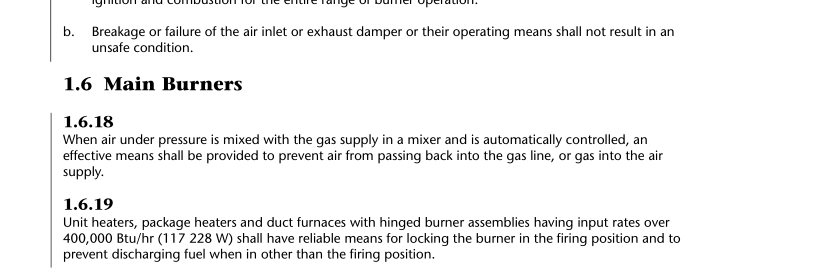CSA 2.6A-2009 pdf download – Gas Unit Heaters And Gas-Fired Duct Furnaces.
1.18.6 Low-static pressure unit heaters and duct furnaces shall have a maximum allowable discharge air temperature of 250°F (1 21 °C). Utility heaters shall have a maximum allowable discharge temperature of 200°F (93.5°C). 1.18.7 High-static pressure unit heaters and packaged heaters of other than the floor-mounted downflow type and for which the manufacturer specifies no clearance to combustible construction less than 6 in (1 52 mm), and at least one such clearance of 1 8 in (457 mm), shall have a maximum allowable air temperature of 250°F (1 21 °C). 1.18.8 High-static pressure unit heaters and packaged heaters of other than the floor-mounted downflow type and for which the manufacturer specifies at least one clearance less than the criteria stipulated in 1 .1 8.7, or a high-static pressure unit heater or packaged heater of the floor-mounted downflow type, shall have a maximum allowable air temperature of 1 00°F (55.5°C) above the maximum temperature rise specified by the manufacturer or 200°F (93.5°C), whichever is less. (Also see 1 .1 8.9.) 1.18.9 At the manufacturer’s option, the maximum allowable air temperature for a high-static pressure unit heater or packaged heater covered by 1 .1 8.8 may exceed 1 00°F (55.5°C) above the maximum temperature rise specified by the manufacturer but not 200°F (93.5°C), if the heater (1 ) has a maximum temperature rise of less than 1 00°F (55.5°C), and (2) complies with: a. The performance provisions of this standard when adjusted to a temperature rise of 1 5°F (8.5°C) less than the maximum temperature rise as specified in 2.1 .1 9; b. The applicable tests specified in 2.1 9, Wall, Floor and Ceiling Temperatures, when adjusted to a temperature rise of 70°F (39°C) less than the optional maximum allowable air temperature; and c. 1.23 Motors And Blowers 1.23.3 Air-circulating motors in low-static unit heaters and utility heaters shall operate at temperatures not in excess of the limits specified in Column 1 of Table F-V, Maximum Allowable Rise Above Room Temperature for Various Component Parts, when operating with the air distribution devices or louvers set at the minimum flow adjustment. At the option of the manufacturer, the temperature of motor windings may be measured by the resistance method. The unit heater or utility heater shall be operated at normal inlet test pressure as specified in 2.1 0, Thermal Efficiency, until motor temperatures have reached equilibrium. 1.23.4 Air-circulating blower motors in high-static unit heaters and packaged heaters shall operate at temperatures not in excess of the limits specified in Column 1 of Table F-V, Maximum Allowable Rise Above Room Temperature for Various Component Parts, when operating at the minimum normal temperature rise and maximum external static pressure specified by the manufacturer. At the option of the manufacturer, the temperature of motor windings may be measured by the resistance method. The unit heater shall be operated at normal inlet test pressure as specified in 2.1 0, Thermal Efficiency, until motor temperatures have reached equilibrium. 1.23.5 The air-circulating blower motor of a direct-drive blower provided on a high-static unit heater and packaged heater shall be capable of operating at a point within the range of air temperatures at the static pressures for which the unit heater or packaged heater is being tested, and at the voltage specified on the motor name plate. For test purposes only, the speed of the blower may be adjusted by reducing voltage from the rated value. 1.31 Instructions 1.31.4 An appliance shall be accompanied by printed instructions and diagrams adequate for its proper field assembly, installation and safe operation, including all controls and accessories.
The letters used for the above boxed warnings shall be boldfaced type having a minimum uppercase letter height of 0.1 20 in (3.05 mm). The minimum vertical spacing between lines of type shall be 0.046 in (1 .1 7 mm).* Lowercase letters shall be compatible with the uppercase letter size specification. These instructions shall indicate the following: a. Manufacturer’s or distributor’s name and address, model, type or series number. b. Adequate clearance around air openings into the combustion chamber, clearances from combustible material and provisions for accessibility and for combustion and ventilation air supply. c. The specific type of Type B vent or vent connector to be used, together with the listed clearances from combustible construction, in the event the appliance is tested with a listed Type B vent or vent connector. (Also see 1 .32.1 8.) d. For an appliance having a specified floor clearance greater than zero, the appliance, if not suspended, should be installed using the noncombustible base or legs provided. (See 1 .2.1 0.)CSA 2.6A-2009 pdf download.
